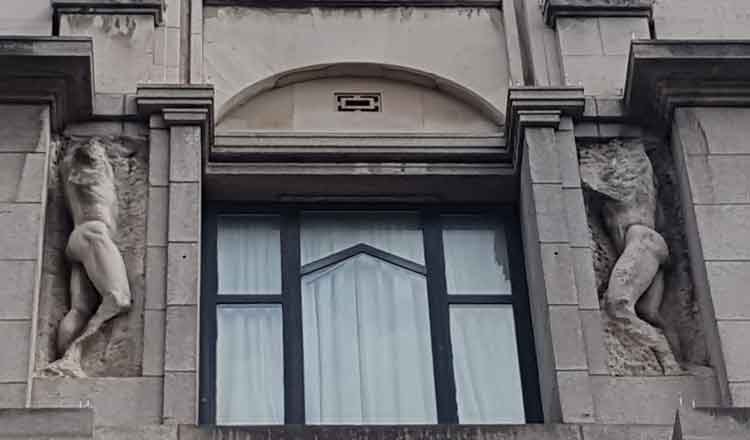
In June, 1908, the self-appointed guardians of London's morals, became decidedly hot under the collar over a series of statues, some of them nude, which had appeared on the upper level of the new British Medical Association (BMA) building on the Strand.
The building in question was the work of the architect Charles Holden, and his design incorporated eighteen tall niches, that would run the entire second floor length of the two outer faces of the building, into each of which could be slotted statues on themes of the BMA's choosing.
Resisting the temptation to fill these alcoves with representations of portly, bewhiskered doctors, the British Medical Association commissioned a young 27-year old sculptor by the name of Jacob Epstein to come up with something that would be worthy of the noble aspirations of its members, whilst, at the same time, giving passers-by in the street below something to look up at and admire.
Thus did Epstein set to work on his first major outdoor commission, and, boy oh boy, did he give people something to look up at by chiseling eighteen colossal figures out of Portland Stone, each figure representing one of the various ages of man and woman from cradle to grave.
With the building nearing completion, the statues were hoisted into place, and the more puritanical elements of Edwardian society took one look at the gloriously detailed representations of naked humanity, gave a collective gasp of disgust, and let out an almighty roar of indignant outrage that would be heard across Europe.
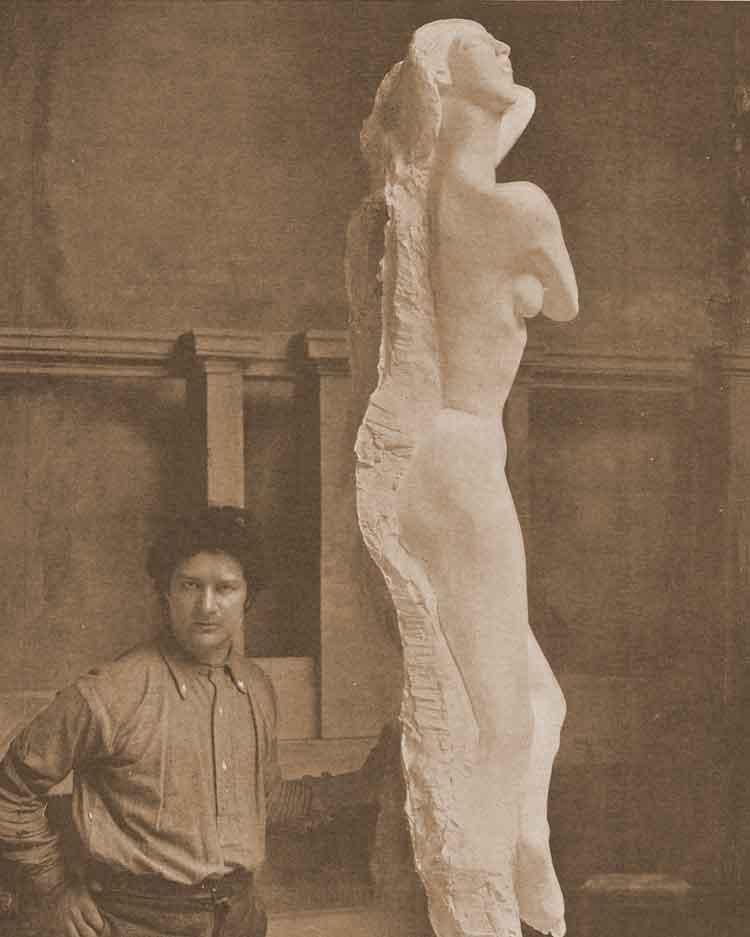
Jacob Epstein At Work On One Of The Statues In His Studio
From
The Sketch, 8th July, 1908
Copyright The Illustrated London News Group and Mary Evans Picture Library
The Evening Standard was quick off the mark to express its disapproval of the pert buttocks and tight muscles that had taken up residence above the Strand, and fulminated at the way in which the sculptures were:-
"...laid bare to the gaze of all classes, young and old, in perhaps the busiest thoroughfare of the Metropolis of the world..."
Next in-line to get an eyeful of the offending body parts and appendages were the boys in blue from Scotland Yard.
One day, Epstein noticed a police constable standing in Agar Street, who was looking up at his creations, whilst furiously scribbling something into his notebook.
Sidling up to the officer, Epstein looked over his shoulder and saw the word "Rude" penciled onto the page.
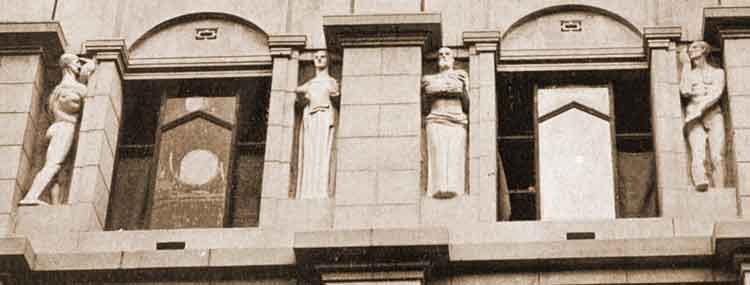
The Epstein Statues In Position On The BMA Building
From The Bystander, 1st July, 1908
Copyright The Illustrated London News Group and Mary Evans Picture Library.
Then, as reported in The Leicester Daily Post, on Monday, 22nd June, 1908, an even more sinister group of moralists joined the fray:-
"The National Vigilance Association has taken action with regard to the statues on the new building of the British Medical Association in the Strand and Agar-street, and Mr. W. A. Coote, the secretary, said that he had lodged a protest with the secretary of the British Medical Association.
At present the sight was bad enough, but when the hoarding in Agar-street was removed it would become a public scandal.
In no other city in Europe were figures were figures in sculpture of the nature shown on the building in the Strand thrust upon the public gaze.
If photographs of the statues were sold in the public streets, or exposed for sale in any shop, proceedings would at once be taken.
The Association intended, unless the offending figures were removed, to take action, and see whether the law was strong enough to deal with such a display. If it were not, the fact would lend additional interest to the proceedings of the Parliamentary Committee, which was inquiring into the publication of certain books and pictures, and the holding of certain exhibitions.
It is understood that Scotland yard have intimated that objection is taken to the figures, and to one of them in particular.
The secretary of the British Medical Association says that they consider the figures, which are 50ft. above the ground, appropriate, and he could not agree that the statues were in any way objectionable."
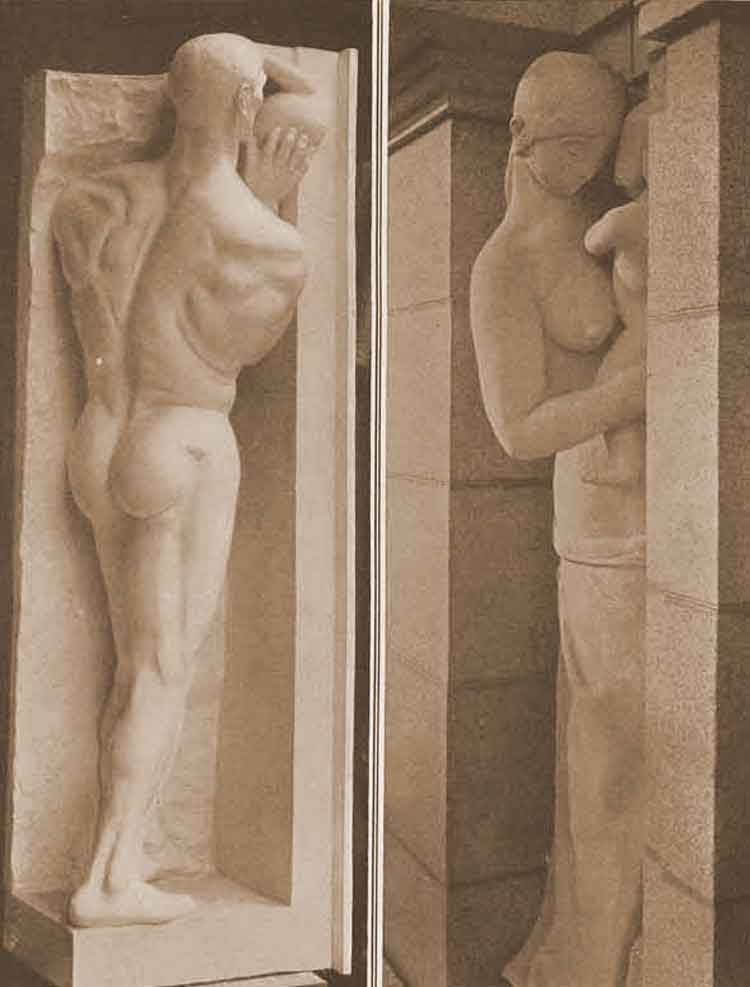
Two Of The Statues. "Maternity" Is To The Right.
From The Sphere, 8th July, 1908
Copyright The Illustrated London News Group and Mary Evans Picture Library
Meanwhile, down in south London, Fr. Bernard Vaughan (1847–1922), addressing a gathering of Clapham Catholics, raged that "the erection of certain statuary" would "desecrate public buildings in the highways".
The South London Press, reported the gist of his objections on Friday, 26th June, 1908:-
"Father Vaughan, referring to the figures on the front of the British Medical Association's offices in the Strand, said he was sorry to say there were those who advocated the erection of certain statuary which would desecrate public buildings in the highways.
They were all entitled to hold their own opinions about the nude in art, but let them keep the nude in its proper place, where it would not appeal to the more vicious in human nature.
Let them keep such statuary in their art galleries and museums, or where people had to go out of their way to find it.
It was not advisable to thrust these statues upon their public highways.
It seemed questionable purity for them to call attention to social purity, and at the same time erect the statues, which, to those who had no artistic temperament - and the artistic temperament was the privilege of the few and not of the many - were offensive."
However, other public figures, as well as many elements of the press, leapt to Epstein's defence.
Dr. Cosmo Gordon Lang (1864 - 1945), the Bishop of Stepney, dropped by to inspect the statues and declared that there was nothing in the least bit indecent or offensive about the figures.
The Yorkshire Evening Post, on Wednesday, 24th June, 1908, reported that a journalist from The Times had conducted a similar inspection and had reached the same conclusion:-
"The committee of the British Medical Association meet today to consider whether the statues on their new building in the Strand ought to be "modified."
A correspondent of The Times who, accompanied by friend, examined the figures from the street, says the statues are at a height of 40ft. to 50ft. from the ground.
The only figures which, in the opinion of the correspondent and his companion, any exception can conceivably be taken, are three or four nude male figures, which, however, are neither indecent nor even remotely suggestive.
The statue of "Maternity" represents a woman in pregnancy. This figure is turned towards the wall, and is so high up on the building, that the particular feature to which exception is taken can be scarcely distinguished, except with the aid of an opera glass or a telescope."
The Globe, on Saturday, 20th June, 1908, under the headline "Prudes On The Prowl", had already opined that:-
"The neglect to supply drapery to certain statues which have been placed upon the new building of the British Medical Association at the corner of Agar-street and the Strand seems to have excited the indignation of a number of very worthy, if not very wise, people, and in particular of the National Vigilance Association.
The excitement they have created raises the whole question of the propriety, or otherwise, of representing the nude in art.
We very much doubt whether one passer-by in a thousand would have detected any impropriety whatever in the Strand statues if it had not been pointed out by people who are continually on the look out for that kind of thing.
Nothing is so prurient as prudery, and prudery allowed to run unchecked will end by discovery unsuspected indecency on every side..."
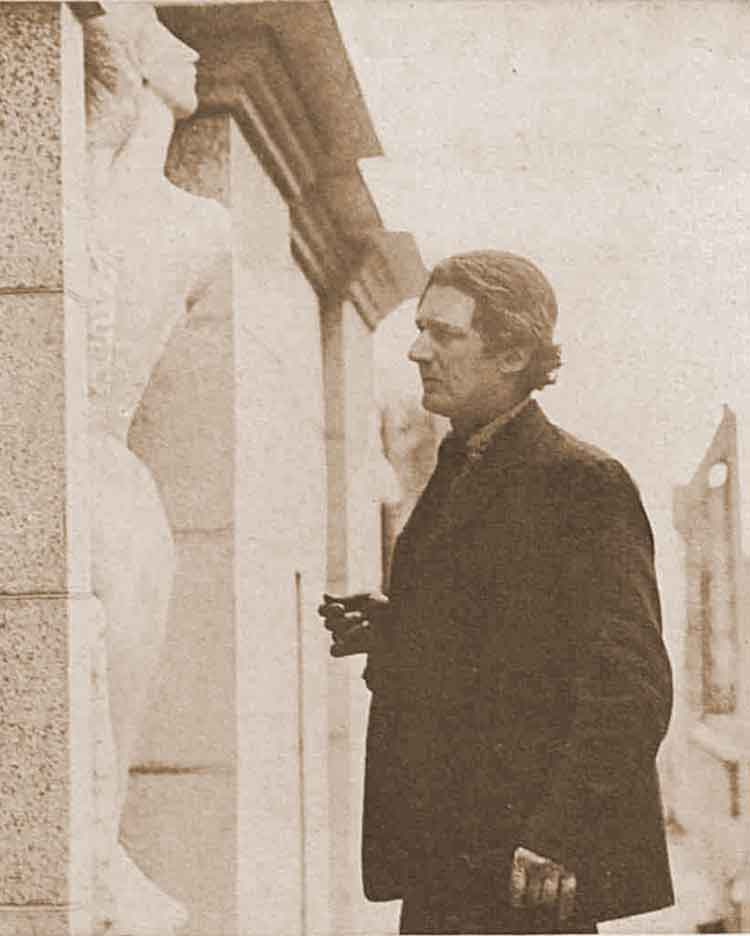
Jacob Epstein At Work On One Of The Statues
From The Sphere, 4th July, 1908
Copyright The Illustrated London News Group and Mary Evans Picture Library
The Sporting Times, on Saturday, 27th June, 1908, thought that the whole rumpus was quite ridiculous:-
"The fuss about the statues on the British Medical Association buildings is really very ridiculous.
A young sculptor is asked design some figures to fill some spaces which are awkward from an architectural point of view.
He, after much thought, sculpts some figures which typify various stages of evolution of man and woman, which, because they happen to be correct to muscle and true to nature, are denounced as being improper, simply because they are nude.
They are not in the least suggestive, and if the first man to write on the subject had declared that they were extraordinarily fine, all London would have praised them to the skies instead of discussing whether clothes should be put on them."
The Bystander, on Wednesday, July 1st, 1908, pointed out that the furor had, in fact, led to a resurgence of interest in London's statues, and suggested that, all the indignant moralists needed to do was bide their time and wait for London's polluted air to do the job of covering the statues:-
"London statuary is enjoying one more little boom now that the figures on the Medical Association's new building, at the corner of Agar Street, have fallen beneath the heavy censure of an evening paper.
No one quite knows what horrors the President of the Association and the newspaper man have seen, but as far as the public are concerned, nothing very frightful has come to light.
Artistically speaking, the work of the clever sculptor, Mr. Epstein, is an admirable solution of a most difficult problem in architectural decoration, but perhaps the man in the street is not greatly interested in that.
In any case, London is very kind to its indifferent sculpture, and covers the just and the unjust alike in a discreet coating of brownish grey, and thus, before the critics have had time to reform us, the sin is forgotten.
This quiet mantle is only removed when some smart writer is looking out for a sensation or wishes to point the moral of our civic lack of art."
However, that same day, Wednesday, 1st July, the Council of the BMA had met to decide whether or not to allow the statues to remain.
As was reported in The Morning Post, on Thursday, 2nd July, 1908, a major figure from the world of Art had waded into the row and had come down firmly on the side of Jacob Epstein:-
"A meeting of the Council of the British Medical Association was held in London yesterday afternoon, Mr. Edmund Owen in the chair, when the statuary on the new premises in this Strand and Agar-street was considered.
A letter from Sir Charles Holroyd, Director of the National Gallery, was read warmly eulogising the sculpture and expressing the belief that the British Medical Association will be proud in future of having given the work to the sculptor who promises to make a name for himself.
After a full discussion, the following decision adopted with acclamation:- That having carefully considered the objections raised, and the many favourable expressions of opinion of eminent authorities on art to the statuary on the new premises, the Council instructs the architect to proceed with the work."
With the decision made not to remove or clothe the statues, the tide of public opinion began to turn against the views of the moralists and people began to appreciate the artistic value of the sculptures.
The Christchurch Times, on Saturday, 4th July, 1908, noted how the publicity that had been given to the statues had resulted in them becoming tourist attractions in their own right:-
"The discussion concerning the nude figures adorning the fine edifice by the British Medical Association in the Strand has resulted in adding a free popular exhibition to the many Exhibitions now attracting crowds to London.
The visitors from the Continent, and from all parts of the country seem to regard the Strand statutes as one of the sights of London, and the street is generally crowded with sightseers bent on viewing the figures, described by Father Vaughan as "objectionable to those who have no artistic temperament."
Most of the visitors appear to claim that they are possessed of the artistic temperament for they linger opposite the new building, and the police find difficulty in clearing the pavements."
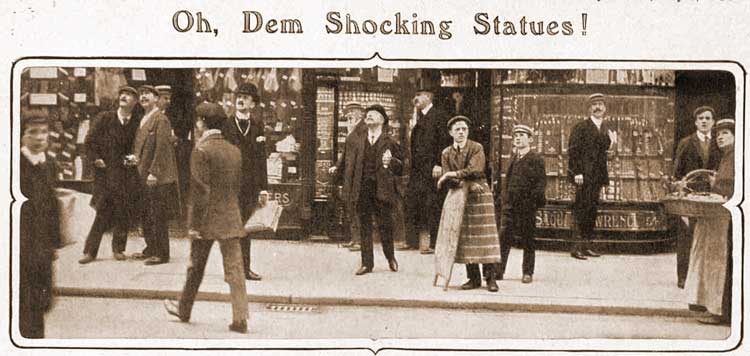
"Pedestrians on the Strand eagerly gazing up at the building of the British Medical Association, in search of the statues which the papers said were rather shocking and ought to be suppressed."
From The Bystander, 1st July, 1908
Copyright The Illustrated London News Group and Mary Evans Picture Library.
The Graphic, on Saturday, 4th July, 1908, wondered whether it wasn't the dirty minds of the objectors that were at fault:-
"The agitation which has been fomented in a certain quarter over the decorative statuary in the Strand is, from ever point of view, to be deplored.
If the object is to remove impropriety from the public ken, the result has been the opposite - it has advertised it to hundreds of thousands who would never have heard of it.
Assuming this statuary to be "indiscreet," not one in a thousand of passers-by would have raised their eyes to these figures embedded in the face of a building forty or fifty feet up.
Of those who would see them, not one in a hundred would learn anything he or she did not know before, and not one in a hundred who learned anything would be soiled with any idea of pruriency.
As to such persons, these severe, archaic, almost repellent figures would pander nothing to a prurient taste, which, prurient already, could not be further contaminated.
Such minds can daily find much greater possibilities of alleged demoralisation in the print-shops—pictures suggestive of a lasciviousness such as the Strand figures would unquestionably banish.
Mr. Epstein's sculptures do not greatly please me personally, as their note is too grim and sculpturesquely brutal for my taste, but I appreciate the noble vigour, the stern purpose, the decorative and architecturic adaptation of the human form to the architectural surroundings.
There is no "prettiness" here, only a sort of pessimistic beauty.
Those who discover something necessarily offensive in the form which was made in God's image, pretend to differentiate between the art of the streets and the art of the galleries.
They don't object to it in museums, they say.
In what does this distinction exist, and what does it mean?
I have always understood that the public galleries have been formed for the public - for those very men, women, and children who walk the streets and gaze up at the public buildings.
Every class is allowed into a gallery - nay, encouraged to go there. Why is it pretended that art is refining on walls inside a building and demoralising on the walls outside? The idea is preposterous.
Moreover, of this you may be certain, it is the half-secrecy that turns art and nature into something improper as may be seen in the case of those who have raised a clamour that must be highly objectionable and offensive to every person of clean mind and healthy taste.
In the case of seriously evolved sculpture, pruriency lies in the eye of him that looks."
As objections against the statues began to wane, The Daily Telegraph and Courier (London), on Tuesday, 7th July, 1908, decided to explain to their readers what some of the statues were intended to represent:-
"From a description in the British Medical Journal of Mr. Epstein's much-discussed statues on the new buildings of the British Medical Association in the Strand it appears that the series represents the origin and growth of life and various phases of scientific study and research.
Of these symbolical figures, perhaps the most striking are those representing Primal Energy, Matter, and Hygeia, the Goddess of Health, all of which are on the Strand side of the building.
At the corner of the building may be seen Chemical Research and Academic Research, represented by figures examining respectively a chemical retort and a scroll of manuscript.
Mentality, the brain, is represented on the Agar-street side of the building by a figure holding a winged skull, symbolic of thought."
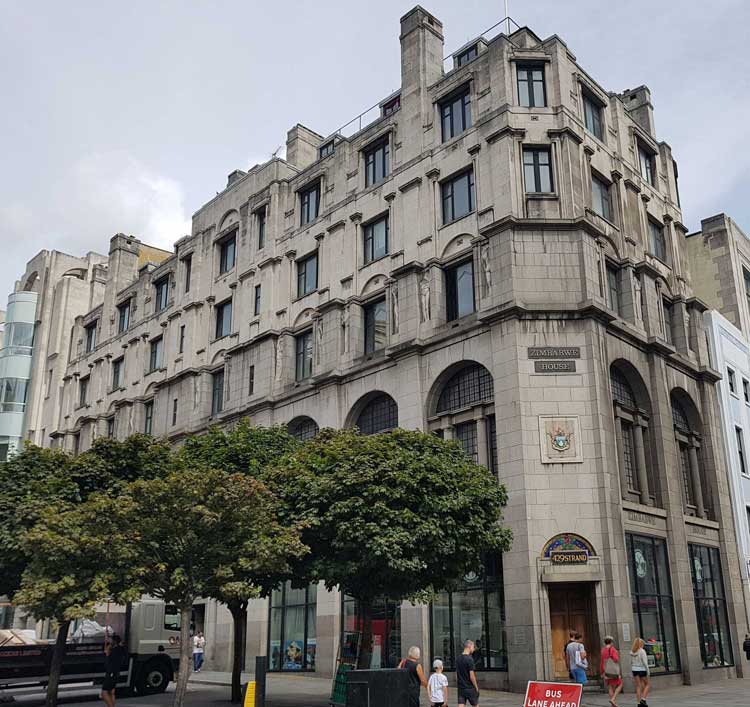
Zimbabwe House, August, 2018
With the moralists conceding defeat, the Strand returned to some semblance of normality and, as the publicity began to die down, so too did the numbers of spectators arriving to view the statues.
But, all was not well on that second floor level of the British Medical Association building.
Epstein, it transpired, had left pockets in the stone of the statues in which rain water could collect, which, in cold winter months led to the formation of frost.
Over the next twenty-six years, as Londoners passed along the Strand, paying less and less heed to the statues, frost damage and foul weather began to take their toll on the sculptures and, by the 1930's, unbeknown to passers-by below, certain parts of Epstein's figures had begun to show signs of decay, and were now in a precarious condition.
In 1934, The British Medical Association decamped to a knew headquarters in Tavistock Square, over in Bloomsbury, and the government of Southern Rhodesia purchased the Strand building, and renamed it Rhodesia House.
Mr. Lanigan O'Keeffe, the High Commissioner for Southern Rhodesia, was no fan of the Epstein figures, and, according to some press reports, had requested that the BMA might consider taking the statues with them to their new premises.
And then, on Thursday, 10th June, 1937, Mrs. E Jameson, of Morningside Road, Liverpool, was walking along the Strand on a visit to London.
As she was passing Rhodesia House, workmen were removing some lights that had been put up on the building for the celebrations surrounding the Coronation of King George VI, which had taken place on 12th May, 1937.
Suddenly, the head of one of the statues toppled from the shoulders of its supporting statue and crashed into the street below.
Fortunately, Mrs. Jameson only suffered a very slight injury to her foot.
But, the accident would reignite the debate about the suitability of the statues for the Strand, and once more Epstein's figures found themselves in the news, this time for safety reasons.
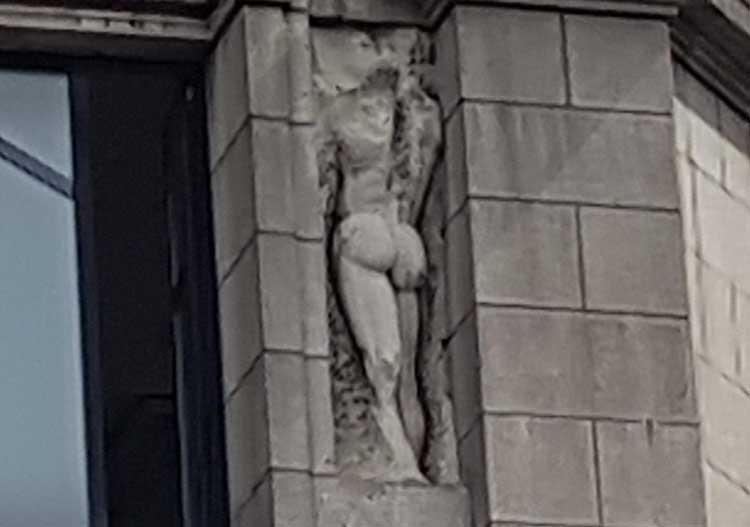
One Of The Disfigured Statues, August, 2018
Alarmed at the prospect that such an accident could have had far more serious consequences, the High Commissioner commissioned an inspection of the statues by a specialist team of experts, and The Yorkshire Post and Leeds Intelligencer reported their findings on Wednesday, 21st July. 1937:-
"When the head one of Epstein's eighteen statues on Rhodesia House, the Strand, recently fell to the pavement, violent controversy was let loose. Should they remain; should they come down?
Before me lies a report issued to-day by the High Commissioner for Southern Rhodesia.
It is the joint work of an architect, a master builder, a mason, a stone-decay specialist, the president of the Royal Society of British Sculptors, and the architect of Rhodesia House.
These six have each examined the Epstein statues.
They found that "the limbs of some of the statues were missing, more were loose or cracked...and that much of the surface stone throughout was pitted and decayed."
That Portland stone should be so affected after only 29 years exposure, the experts ascribe to the use of stone "not of the best variety," and the collection of wet, dirt and soot in places where the stone was "too deeply cut away" and the projection of the figures beyond the granite niches which contain them.
They recommend the removal of the figures.
But they advise that casts be taken so that "these early masterpieces of Mr. Epstein's genius should find a worthy home in some public gallery."
Epstein was not impressed by the findings of the experts, believing, as he told The Yorkshire Post and Leeds Intelligencer, that the High Commissioner was simply using the safety issue to achieve what he had wanted all along, since moving into the building:-
"Mr. Jacob Epstein, commenting on the report, said, "I received a letter from the High Commissioner saying that he could give no assistance of any sort to make an investigation or report regarding my statues, of which I am course only the spiritual owner.
I cannot appreciate the compliment of Mr. O'Keeffe, regarding myself or the statues, because, in my view, he is, at heart, glad of the opportunity presented by the experts to get rid of the statues."
The Daily Herald, on Thursday, 1st July 1937, had sided with the High Commissioner, and pointed out how the argument had caused a usually reticent Epstein to become uncharacteristically vociferous:-
"Sculptor Jacob Epstein is breaking down.
In the old days be would never give newspaper interviews, never write articles, never bother to correct people's wrong ideas about his work.
The Statues in the Strand dispute has moved him to rare reproof.
Usually Epstein administers the shocks. This time the threatened removal his symbolic figures has shocked him.
They should be moved - to a position where they can be seen. The figures are 40 feet above the ground.
Even when they were unveiled critics had to view them through field glasses before they could release an accurate storm of protest.
Now, London grimy, they are still more difficult to see."
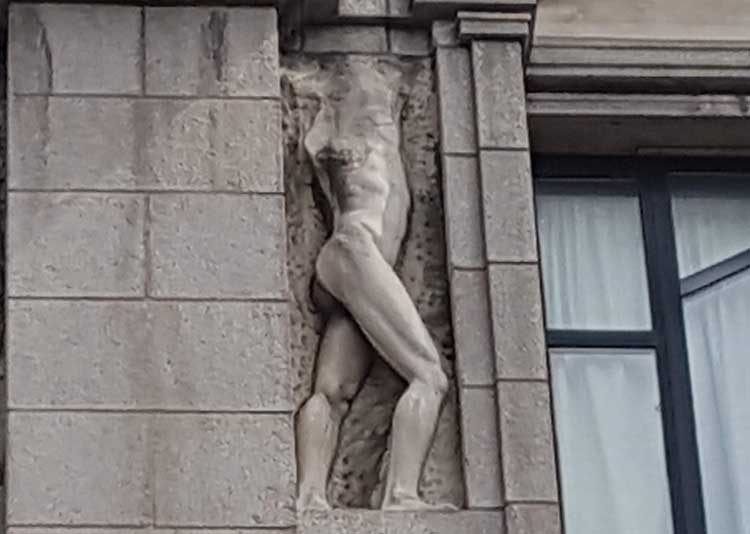
One Of The Disfigured Statues, August, 2018
Mr. O'Keeffe tried to strike a conciliatory note with the irate sculptor, telling the Aberdeen Press and Journal, on Thursday, 22nd July, 1937:-
"Perhaps good may come out of evil if, through the generosity of donors, casts can be taken of the statues and these early masterpieces of Mr Epstein's genius should find a worthy home in some public gallery."
Epstein though was in no mood for flattery, and his response to O'Keeffe's olive branch was reported by Aberdeen Press and Journal:-
"Mr Jacob Epstein, commenting on the report, said, "All this slobbering means nothing.
The report is just a white-washing affair to let them accomplish what they set out to do originally - destroy the statues."
However, it was then decided that it would be impossible to remove the statues without damaging the fabric of the building.
So, a compromise was reached, and it was decided that only "the decaying pieces of stone" would be removed.
In mid-August, 1937, work got underway and Sir William Reid Dick, President of the Royal Society of British Sculptors, was called upon to inspect the statues and decide which parts needed to be removed.
The Dundee Evening Telegraph, reported on his involvement on Wednesday, 18th August, 1937:-
"The controversy over the Epstein statues on Rhodesia House continues in art circles, but today may see the end of the whole thing.
Sir William Reid Dick, President of the Royal Society of British Sculptors, has consented to visit Rhodesia House and mark the limbs and heads of the statues that must be amputated as a measure of public safety.
After this the London County Council surveyor will see whether the building may considered no longer dangerous and the scaffolding that protects pedestrians removed..."
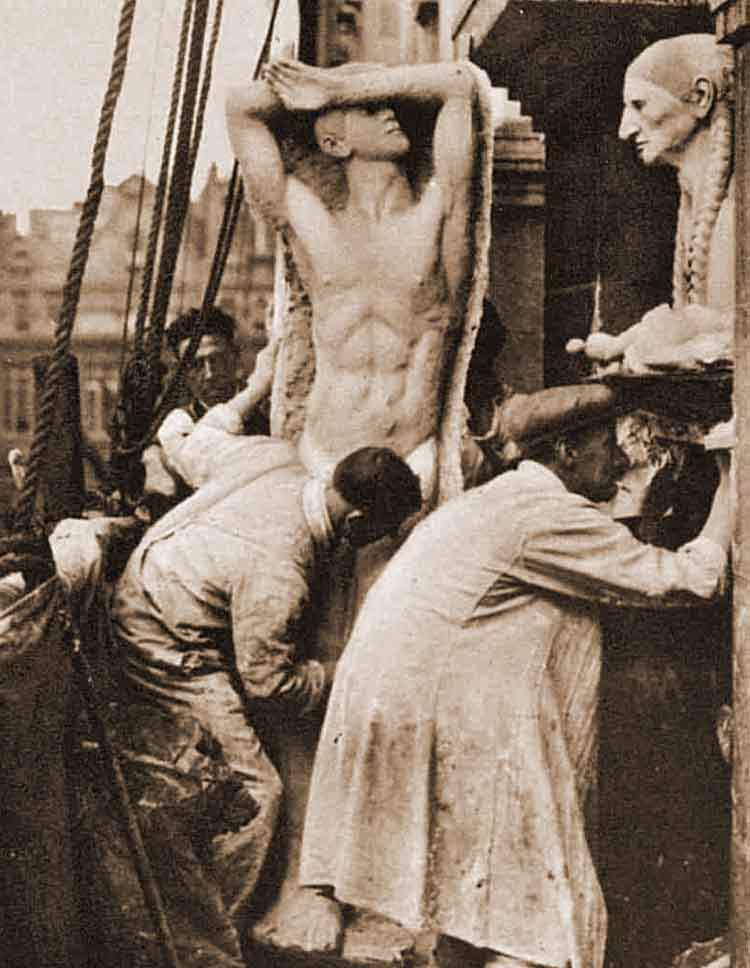
Work Commences On Removing The Dangerous Parts Of The Statues
From The Bystander, 25th August, 1937
Copyright The Illustrated London News Group and Mary Evans Picture Library.
The Birmingham Daily Gazette, on Monday, 23rd August, 1937, remembering the original occupants of the building, couldn't resist enjoying a little fun with what many saw as the desecration of works of art:-
"The building from which the early Epstein statues are now being removed piecemeal was once the headquarters of the British Medical association. So at least Mr. Epstein cannot complain that the amputations is inappropriate."
Rhodesia House is now Zimbabwe House, and the damaged statues are still in situ on the upper level of the building.
Few people, making their way along the Strand ever stop to take note of them. Indeed, the majority of pedestrians who pass beneath them are oblivious to their presence.
So, the next time you find yourself on the Strand, why not pause at its junction with Agar Street. Crane your neck upwards, and admire what remains of the colossal Jacob Epstein creations that once scandalised London.